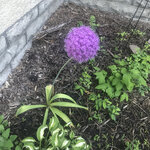



Now that the days are becoming noticeably shorter and nights are getting colder, you may think the planting season is over. However, fall is the perfect time to put some hardy bulbs in the ground for early spring blooms! With a bit of advance planning, you can look forward to seeing flowers as soon as possible next year. Read on for tips and advice on choosing, planting, and caring for hardy bulbs.
First, some terminology. “Bulb” refers to a type of plant that stores nutrients underground in a large rounded structure. Technically, there are several different bulb-like structures that serve similar functions, including true bulbs, tubers, rhizomes, and corms, but for our purposes we will refer to them all as “bulbs.” There are two main types of bulbs: “hardy” and “tender.” Hardy bulbs are planted in the fall and bloom in the spring. Daffodils, tulips, snow drops, crocuses, irises, and hyacinths are all great examples of hardy bulbs. Tender bulbs (such as canna and calla lilies) are planted in the spring, bloom in the summer, and must be dug up and stored indoors over the winter.
This article will focus on the tougher and easier to care for hardy bulbs.
You can plant hardy bulbs anytime after the soil cools in the fall, but before the ground freezes. If you can still dig a hole, you can still plant a bulb! Cool soil temperatures encourage the plant to focus on growing roots and storing nutrients for the spring. Generally, bulbs should be planted in a hole with a depth 2-3 times the height of the bulb. Hardy bulbs do best when planted in well-draining soil, and somewhere that will have full sun in the spring (but keep in mind that the trees won’t have leaves yet, so most locations will have full sun unless they are shaded by a building or other structure). Make sure to plant bulbs with the pointy side up and mark their location so you don’t forget and accidentally dig them up in the spring!
One planting tip from personal experience: squirrels love to dig up fall-planted bulbs, so consider planting them at the maximum recommended depth or placing some chicken wire or other protection over the top of the bulbs. After a disappointing year when I planted 75 crocus bulbs and only had a handful survive the squirrels, I started using bulb baskets with great success. These are plastic baskets with perforated lids that keep squirrels out but allow bulbs to grow through. Essentially, you plant the bulbs in the basket and then bury the entire basket at the appropriate depth for the bulbs. I like to recommend this method for maximum squirrel protection!
Hardy bulbs are easy to care for, but there are a few best practices to promote healthy plants and vibrant blooms. In the spring, you can encourage growth by pushing mulch aside when soil and air temperatures begin to warm. Most early spring bulbs can tolerate a light frost, so no need to worry unless the temperature dips into the 20s for an extended period. It’s best to remove faded flowers after blooming so the plant puts its energy into the bulb and not into seed production. However, do not remove leaves until they are yellow and withered, to give the plant as much time as possible to photosynthesize nutrients and store them for the following year. Additionally, be careful not to overwater bulbs as they are prone to rotting if soil conditions are too wet.
Most bulbs will multiply, and after several years, they may start to become crowded and not bloom as well. Every three to four years, consider dividing your bulbs to give them more space. Shortly after the foliage has died back, dig up the bulbs, remove any loose soil, and store them in a cool, dry spot until it’s time to plant them again in the fall.
Finally, if you want to add something slightly unusual to your garden, my personal favorite hardy bulbs are alliums. These are decorative onions that feature a large puffy flower on a tall stalk. There are many types of alliums with different colors and heights, but they all have a charming Dr. Seuss-esque quality that livens up the garden throughout the year!
For more information, check out the University of Minnesota Extension Yard and Garden website. Extension resources are written by experts, and contain the latest and most reliable research-based information. Happy gardening!
Comments
No comments on this item Please log in to comment by clicking here